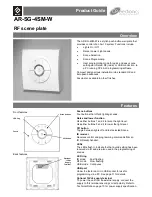
BankGuard PLUS
S&C Electric Company
Control
Proprietary Information
18
Operation
1011-540 5-17-04
•
When an ungrounded wye capacitor bank installation has the Unbalance Compensation
feature disabled, the Discrete Fourier Transform algorithm yields the magnitude of the
neutral-to-ground voltage. This magnitude is then compared to the setpoint value(s) to
determine if any control action is to be executed.
•
When an ungrounded wye capacitor bank has the Unbalance Compensation feature set
to “Cap Only,” the Discrete Fourier Transform algorithm yields the magnitude of the
neutral-to-ground voltage (|V
N-G
|) and the value of the phase angle (A
ref
) between the
neutral-to-ground voltage and the reference line voltage. Using the Law of Cosines, an
approximate correct magnitude is obtained utilizing the reference angle (See Figure 4-4).
An approximate corrected magnitude is calculated and stored in the control’s memory
during the feature’s setup procedure. When the control is operating, the stored
approximate corrected magnitude is subtracted from the real-time neutral-to-ground
voltage magnitude during each 200 milliseconds to obtain a compensated neutral-to-
ground voltage magnitude. The compensated neutral-to-ground voltage magnitude is then
compared to the setpoint value(s). If the compensated neutral-to-ground voltage
magnitude exceeds a setpoint value, then the appropriate control action will be taken.
Figure 7
Approximate Corrected Magnitude
•
For an ungrounded wye capacitor bank with the Unbalance Compensation feature set to
“Cap/Line,” the Discrete Fourier Transform algorithm yields the magnitude of the neutral-
to-ground voltage, the magnitude of the sum of the line voltages(|V
L-G sum|
) and a
reference angle (A
ref
). Since the sum is obtained from the three line voltages,
compensation for fixed system voltage imbalances is provided in addition to capacitor unit
manufacturing tolerance. Using the Law of Cosines, a corrected magnitude is obtained
(See Figure 4-5). A corrected magnitude is calculated and stored in the control’s memory
during the feature’s setup procedure. When the control is operating, the stored corrected
magnitude is subtracted from the real-time neutral-to-ground voltage each 200
milliseconds to obtain a compensated neutral-to-ground voltage magnitude. The
compensated neutral-to-ground voltage magnitude is then compared to the setpoint
value(s). Capacitor unit failures will cause a change to the real-time neutral-to-ground











































